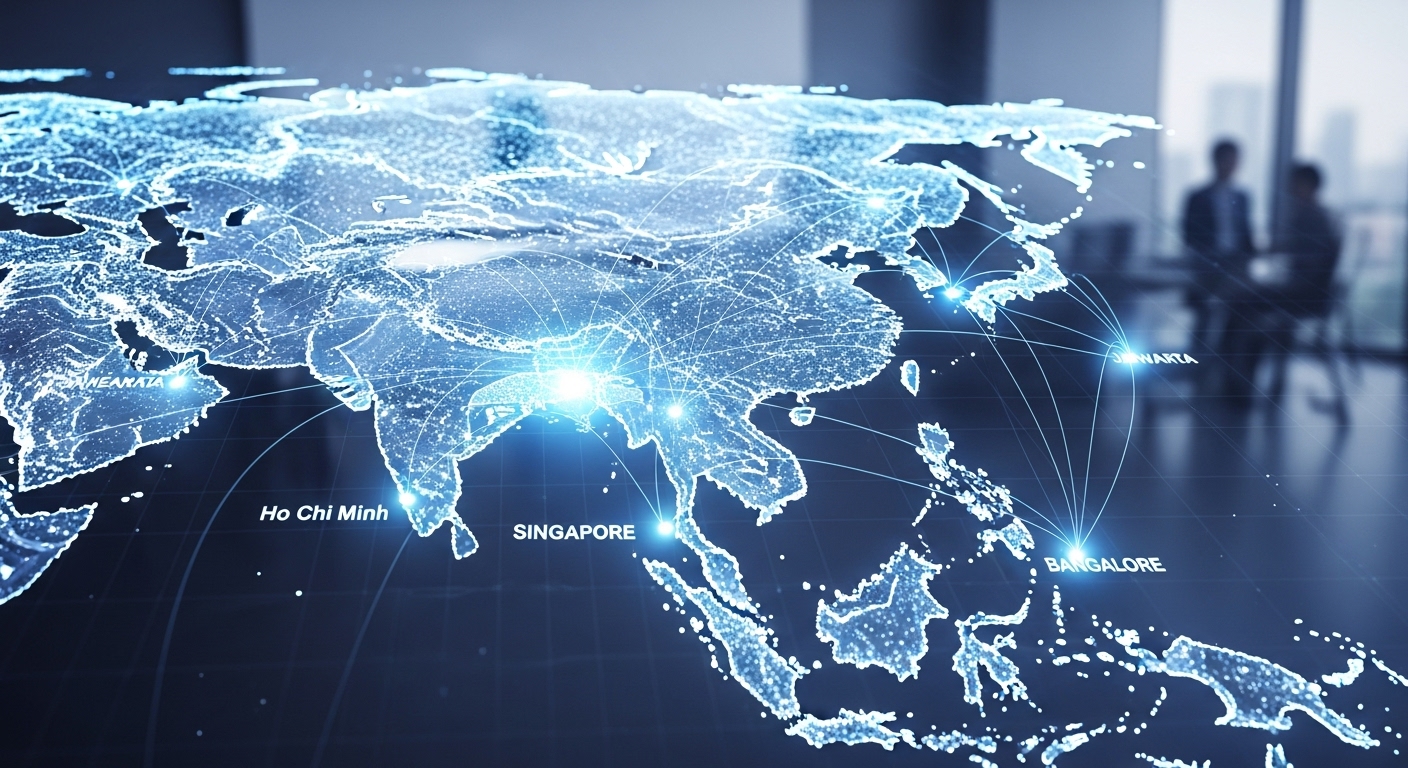The era of planting a single flag in Asia-Pacific and calling it a regional strategy is over. Spurred by geopolitical shifts, unprecedented supply chain disruptions, and the strategic imperative to de-risk operations, businesses are abandoning the monolithic headquarters model. The new paradigm is one of agility, resilience, and distributed presence. Welcome to the ‘Core-Edge’ framework—a sophisticated approach to building a robust and responsive APAC footprint. This strategy involves anchoring your operations in stable, mature ‘core’ hubs like Singapore or Sydney while simultaneously tapping into the explosive growth and specialized talent of dynamic ‘edge’ markets such as Ho Chi Minh City or Bangalore. It’s about creating a strategic network that balances stability with opportunity, providing a diversified foundation for sustainable growth. This article will deconstruct the Core-Edge model, analyzing the strengths of key hubs, outlining a framework for seamless integration, and exploring how this approach future-proofs your business against the volatility of the world’s most dynamic economic region.
The new APAC imperative: From a single headquarters to a strategic network
For decades, the standard playbook for multinational expansion into Asia-Pacific was straightforward: establish a regional headquarters (RHQ) in a major financial center like Hong Kong or Singapore. This centralized model offered simplicity and control. However, recent global events have exposed its inherent fragility. The COVID-19 pandemic revealed the dangers of concentrating supply chains and critical functions in one location, while escalating geopolitical tensions have made single-market dependency a significant liability. The modern business landscape demands a more sophisticated approach—a shift from a single point of failure to a resilient, interconnected network. This is where the Core-Edge strategy comes into play. It’s a polycentric model that builds a strategic portfolio of locations, each with a distinct role. ‘Core’ hubs provide the bedrock of the operation. These are politically and economically stable cities with world-class infrastructure, deep talent pools, and robust legal frameworks. They function as centers for governance, finance, and high-level strategic decision-making. ‘Edge’ hubs, in contrast, are high-growth, often lower-cost markets that offer specialized advantages. They might be manufacturing powerhouses, burgeoning tech ecosystems, or massive consumer markets. By creating a network of these complementary locations, a company can achieve unparalleled resilience. If one hub faces disruption, others can absorb the pressure. This distributed model not only mitigates risk but also enhances market responsiveness, allowing businesses to be physically closer to diverse customers, suppliers, and talent pools across the vast APAC region.
Anchoring your strategy: Evaluating the core hubs of Asia-Pacific
The foundation of any successful Core-Edge strategy lies in selecting the right anchor locations. These core hubs are the nerve centers of your regional operations, providing stability, access to capital, and a predictable regulatory environment. Choosing them requires a careful evaluation of their unique strengths. Singapore is often considered the quintessential core hub. Its unmatched political stability, strong rule of law, and strategic location as a gateway to Southeast Asia make it a safe harbor for international business. Its world-class port and airport cement its role as a premier logistics and supply chain nexus, while its deep talent pool in finance and technology attracts significant foreign investment. Hong Kong, despite recent political shifts, remains a dominant financial gateway to mainland China. Its free-market economy, simple tax system, and highly developed capital markets make it an indispensable hub for businesses focused on the Chinese market. It serves as a specialized core hub where financial services and cross-border trade are paramount. Further east, Tokyo represents a different kind of core. As the capital of the world’s third-largest economy, it offers unparalleled access to a mature, wealthy domestic market and leads the globe in advanced manufacturing, robotics, and high-tech R&D. While its business culture can be challenging to navigate, its reputation for quality and innovation is a powerful asset. Finally, Sydney stands as the primary core hub for Oceania. With strong economic and cultural ties to the wider APAC region, it offers a stable, transparent business environment and a high quality of life that attracts top-tier global talent, particularly in fintech, professional services, and the creative industries.
Tapping into hyper-growth: Identifying the dynamic edge hubs
While core hubs provide stability, edge hubs are the engines of growth and specialization. These cities are characterized by their dynamic economies, rapidly developing infrastructure, and access to specific, high-value talent pools or markets. They are essential for companies looking to diversify supply chains, innovate rapidly, and capture the region’s burgeoning consumer demand. Ho Chi Minh City in Vietnam has emerged as a primary beneficiary of the ‘China+1’ supply chain diversification strategy. Its young, educated, and highly motivated workforce, coupled with government incentives for foreign investment, has made it a manufacturing powerhouse. Its rapidly growing middle class also presents a significant consumer market opportunity. In Indonesia, Jakarta is the undisputed digital economy titan of Southeast Asia. Home to a massive, young, and mobile-first population, it has become a hotbed for e-commerce, fintech, and ride-hailing unicorns. For businesses with a direct-to-consumer digital model, Jakarta offers scale that is hard to match. Bangalore, known as the ‘Silicon Valley of India,’ is a premier edge hub for technology and R&D. It boasts an incredibly deep pool of highly skilled software engineers and IT professionals, all within a vibrant startup ecosystem fueled by global venture capital. Companies establish a presence here to tap into world-class innovation at a competitive cost. Lastly, Kuala Lumpur in Malaysia offers a unique blend of cost-effectiveness, multilingual talent, and excellent infrastructure. It has carved out a niche as a leading center for global shared services, business process outsourcing, Islamic finance, and digital services, providing a stable and efficient base for regional operational support.
The integration challenge: Weaving your core and edge hubs into a cohesive system
Architecting a network of core and edge hubs is only half the battle; the true challenge lies in integrating them into a single, seamless operational system. A disconnected portfolio of offices creates silos, breeds inefficiency, and undermines the very resilience the model is designed to create. Successful integration hinges on three pillars: technology, culture, and clearly defined roles. The technology backbone is non-negotiable. A unified cloud infrastructure, enterprise-wide collaboration platforms like Microsoft Teams or Slack, and integrated Enterprise Resource Planning (ERP) systems are essential for ensuring that data and communication flow freely across geographical boundaries. This digital nervous system provides a single source of truth and enables real-time collaboration, regardless of location. Equally important is the cultural connective tissue. A company must proactively build a unified corporate culture that transcends national borders. This can be achieved through strategic initiatives such as leadership rotations between offices, the formation of cross-hub project teams, and the establishment of shared company-wide rituals and communication cadences. These efforts ensure that an employee in Jakarta feels as connected to the company’s mission as an executive in Singapore. Finally, each hub must have a clearly defined and specialized role. This prevents redundancy and fosters deep expertise. For example, the Singapore office might handle regional finance and strategy, Ho Chi Minh City could oversee manufacturing and supply chain logistics, while Bangalore drives all software development. This functional specialization makes the entire network more efficient and allows each location to excel at what it does best.
Supply chain resilience: Designing a logistics network for a volatile world
Nowhere is the value of the Core-Edge model more apparent than in supply chain management. The Suez Canal blockage, port lockdowns during the pandemic, and ongoing trade disputes have starkly illustrated the vulnerabilities of centralized, single-route logistics. A distributed network of hubs provides the redundancy and flexibility needed to navigate this volatile environment. In this framework, core hubs with world-class infrastructure, like the Port of Singapore or Hong Kong International Airport, serve as the primary consolidation and distribution centers. They are the stable, high-capacity nodes that connect your APAC operations to global trade routes. Their advanced customs systems, free trade zones, and extensive networks of freight forwarders ensure efficiency and reliability for high-volume movements. The strategic value is amplified by the edge hubs, which are positioned closer to manufacturing sites or key consumer markets. A facility near Ho Chi Minh City provides crucial first-mile connectivity for Vietnamese suppliers, while a distribution center in Jakarta can ensure faster last-mile delivery to Indonesia’s massive consumer base. This geographic diversification creates redundancy. If a core port becomes congested, cargo can be strategically rerouted through a secondary hub. Technology is the glue that holds this logistics network together. Modern platforms offering real-time track-and-trace visibility, AI-powered demand forecasting, and integrated warehouse management systems are critical. They allow a company to see its entire supply chain at a glance and make agile decisions to reroute shipments, reallocate inventory, and ultimately keep goods moving despite localized disruptions.
Future-proofing your APAC footprint: Talent, sustainability, and digital transformation
Building a resilient APAC footprint is not just about mitigating current risks; it’s about positioning your organization for future trends. The Core-Edge model provides a flexible framework to adapt to the defining forces of the next decade: the war for talent, the imperative of sustainability, and the relentless pace of digital transformation. In terms of talent, a multi-hub strategy is a powerful competitive advantage. Rather than being confined to the talent pool of a single city, you can access a diverse range of skills across the region. This means tapping into the elite financial expertise in Hong Kong, the world-class engineering talent in Bangalore, and the multilingual customer service professionals in Kuala Lumpur. This distributed approach allows you to find the best talent for the right role, wherever it may be. Sustainability, or ESG (Environmental, Social, and Governance) criteria, is increasingly a critical factor in location analysis. A distributed network allows a company to strategically place operations in countries with favorable green policies and access to renewable energy. It enables alignment with initiatives like Singapore’s Green Plan 2030 or tapping into Australia’s growing renewable energy sector. This not only enhances corporate reputation but also de-risks operations from future carbon taxes and regulations. Finally, the strategy inherently supports digital transformation. The future of business is built on data, and a multi-hub presence requires robust digital infrastructure. This prompts investment in secure cloud networks, regional data centers, and 5G connectivity, ensuring your entire APAC operation has the high-speed, reliable digital backbone required to compete and innovate in a digitally-driven economy.
Ultimately, navigating the complex and fast-evolving Asia-Pacific landscape requires a strategic evolution away from centralized control and towards a distributed, resilient network. The Core-Edge framework provides a practical blueprint for this transition. By carefully balancing the stability and infrastructure of core hubs like Singapore and Tokyo with the high-growth potential and specialized capabilities of edge cities like Jakarta and Ho Chi Minh City, businesses can build a footprint that is both robust and agile. This is more than just a geographic diversification strategy; it is a fundamental rethinking of how to operate in the 21st century. It allows companies to mitigate geopolitical and supply chain risks, access a wider and more diverse talent pool, and get closer to the region’s dynamic consumer markets. For leaders aiming to achieve sustainable, long-term success in the world’s most critical economic region, the message is clear: the future is not about finding a single dot on the map, but about skillfully architecting the connections between them.





